Friend Paul
If it weren’t for the greatness of Viktor Korchnoi, examined in the first part of this series, the Estonian Paul Keres would have easily taken the number one spot on the “greatest player never to become World Champion” list.
During his career, Paul Keres displayed amazing consistency and longevity. Brilliant tournament victories, multiple SSSR Championship wins, golden Olympic medals, attractive attacking style and four(!) second places in the Candidates tournament over the span of 20 years make him one of the giants of our ancient game.
Especially when one learns about all the political and historical circumstances that weren’t in his favour for the most part of his career.
His greatness was acknowledged recently with a series of brilliant articles by Estonian Historian Joosep Grents for chess24.com.
Those articles are wonderful and very informative and they say a lot about Keres’ life off the board, about his early days and about his psychological state during the key moments of his career. The series is a fantastic read, and I can’t recommend it highly enough.
In this article, I will focus on the key tournaments of Keres’ life and most important games he played in those tournaments.

AVRO 1938 – THE TOURNAMENT OF THE CENTURY
The first major breakthrough in Keres’ career was his victory in the celebrated AVRO tournament held in 1938.
The tournament held in 1938 sponsored by Dutch radio company Avro is probably the most famous chess event of the 20th century.
It is impossible to grasp its importance without explaining the circumstances under which it was held.
For starters, the 1930s were the years in which the change of the generations was quite obvious.
Although Alexander Alekhine was still the champion prior to this tournament, his age was beginning to tell and he wasn’t able to demonstrate his dominance in the tournaments of those times.
Jose Raul Capablanca was also a mere shadow of a player he once was. These classical titans found it hard to fight against the gladiators of the new age.
And there was quite a number of gladiators during those years:
- the American hopes Samuel Reshzevsky and Reuben Fine
- the Russian champion and future World Champion Mikhail Botvinnik
- the Czechoslovakian Grandmaster Salo Flohr
- the Dutch Grandmaster Max Euwe, who managed to beat Alekhine in the 1935 World Championship match
There was a lot of fuss in the selection of the new World Championship challenger. After Alekhine defeated Euwe in the return match in 1937, the natural question arose: “Who’s next.”
FIDE decided to solve the question very elegantly. During a congress held in Stockholm, they selected the Czechoslovakian Salo Flohr with a simple voting system (?).
The match was supposed to be scheduled in 1939, but Hitler intervened…
Therefore, after lengthy discussions, it was decided that AVRO 1938 will be treated as a Candidates tournament.
Well, sort of. The winner would not gain the automatic right for a match against Alekhine. The Champion still had the choice in challenger selection, but he was supposed to take the results of the AVRO in the account.
The tournament itself was the strongest tournament of those times. The participants were:
- Paul Keres
- Reuben Fine
- Alexander Alekhine
- Jose Raul Capablanca
- Max Euwe
- Salo Flohr
- Mikhail Botvinnik
- Samuel Reshevsky


The tournament was double round-robin with every round played in the different city. This system was very difficult for the older participants, and final results confirmed this assumption since first three places were won by players of the young generation. Therefore, AVRO also symbolically marked the definite end of the era of classical giants like Alekhine and Capablanca.
The joint first place was divided between Paul Keres and Reuben Fine. Both scored +3, but their tournament paths were quite different.
Whereas Fine won 5 out of his 6 first games (!!) and at the end played 9 decisive games (+6-3=5), Keres’ play was more restrained and pragmatic.
His result (+3-0=11) is more resemblant of a tournament result from the 21st century. He basically wasn’t in serious trouble of losing in any of the games and he used his opportunities and won his games in convincing style.
Consider for instance his first win of the tournament, his fourth round demolition of the Samuel Reshevsky:
Apart from Reshevsky, Keres also beat Capablanca with the White pieces, and Fine with the Black pieces.
Although his game against Capablanca is probably more famous, I think that his victory against Fine is more significant from tournament’s perspective.
The game was played in the 7th round, and Fine was on +5 already. In order to retain hopes of ultimate success, Keres had to beat him and stop his streak.
Many years later, Keres called this game the most important game of his career:
Thus, after the first half of the tournament, Keres was on +3, half a point behind Fine. However, considering that the latter went on to lose a number of games in the second half, Keres pragmatically decided to draw a lot of games in the second half of the tournament.
He didn’t deviate from this strategy even in the last round when he played Fine with the White pieces. Even though the two players shared the lead before the last round, they decided to go for a quick draw, reckoning that risking shared first is not worth it.
Therefore, they shared the lead, and Keres was welcomed triumphally in his motherland of Estonia.

FROM AVRO TO THE END OF WORLD WAR II – ALMOST A WORLD CHAMPION
After AVRO, it became quite clear that Keres is one of the strongest players on the planet and he should have gained the right to challenge Alekhine for the title.
Alas, the match between them never took place. In the parts III and IV of his article, Joosep Grents explains in greater detail why that was so. I will summarise the key points here.
Keres basically had two opportunities for the match with Alekhine until the latter’s death in 1946.
The first happened directly after his AVRO triumph. After his victory, a meeting with Alekhine was scheduled, where details of the subsequent match were expected to be arranged.
However, Keres was forestalled by… Botvinnik. After his victories against Capablanca and Alekhine, Botvinnik thought he has gained the right to challenge Alekhine as well.
If I may add my personal opinion, I think that this egotistic behaviour was typical of the 6th World Champion. Apparently, the significance of the AVRO tournament result was not that relevant to him.
Therefore, Alekhine was reluctant to sign any written arrangement with Keres. Similarly, as he used supposed money to avoid the rematch with Capablanca, he now used the monetary questions again to avoid defining anything about his match with Keres.
Therefore, Keres left, the AVRO company refused to meet Alekhine’s demands and the question of the next challenger was left hanging.
But then the World War II intervened.

You might remember that Estonia was invaded by the Germans during Operation Barbarossa in 1941. Keres, a former Soviet citizen, now found himself on the wrong side of the line.
It is then when the second opportunity for a match against Alekhine appeared. Alekhine was a Nazi collaborator since the invasion of the France in 1940 (check his Wikipedia page for the explanation why he decided on that).
Therefore suddenly, old rivals were once again competing in World War II tournaments held in the territory of the Third Reich.
Allegedly, it was during those years that Alekhine repeatedly asked Keres to play a match for the title. Somehow, our good Paul always refused; Alekhine attributed that to fear. His famous phrase says that: “They all wait until I’m 60 to play for the title.”
However, the reasons for refusal were explained much later by Paul Keres himself:
“What can Alekhine grant me? What kind of importance would such a contest even have? If I won the match I’d gain a bunch of worthless German marks. (…) Would it even be a match for the World Championship title? It would be a match to become the champion of a certain part of the world, that occupied by the German army… If I lost the match, though, I would forever lose the chance to compete for the title following the inevitable end of the war, and would likely lose my right to seize the World Championship title.”
Can you imagine? The spirit of the times, the uncertainties of the war and ignorance about the future.

1948 WORLD CHAMPIONSHIP TOURNAMENT
Thus, it turned out that the return match with Euwe will be the last match for the World title of Alekhine’s life.
After his death in 1946., the natural question of filling the void arose.
At the FIDE Congress in The Hague in 1947, it was decided that the question of the World Champion will be solved by a World Championship Tournament. Half of the tournament was held in the Hague, another half in Moscow.
However, before proceeding directly to the tournament, it is worth mentioning the path of Paul Keres just after the war.
As mentioned above, during the War he participated in Chess events organised by Nazi Germany.
As if that alone was not enough, he was also accused of maintaining friendly relations with Estonian Nationalists. (once again, check here for more details).
However, someone was sober enough to protect Keres from the terrible fate of Siberian gulags. But that doesn’t mean there weren’t any consequences:
- first Keres was stripped of the title of Soviet Grandmaster
- he was also forbidden from participating in chess competitions
- even after his slight rehabilitation, he was banned from international competitions. This made him miss the 1946 Groningen tournament, the strongest post-war tournament, even though organisers invited him personally.
(Once again, check this article for more details about Keres’ war path).
On the other hand, Botvinnik enjoyed the full support of the Soviet authorities, he played (and won) in Groningen and pretty much everybody in the Communist party wanted him to become the new Champion since he was considered to be an ideal Soviet prototype.
The difference in their character was also apparent. The Botvinnik was a machine, methodical worker dedicated to his goal that should be achieved by any means necessary.
For Keres, on the other hand, the most important thing was to remain gentleman until the very end.
“He was most of all upset with people who were full of themselves. He was most upset with discourtesy. He did not really tolerate people who would use any means conceivable to achieve their ends. He always thought that one has to remain a gentleman.”
You get the feeling that Keres was the true definition of a nice guy; it is no wonder that Botvinnik got the feeling that Keres was often let down by his nerves. After surviving interrogation by the KGB, who wouldn’t be?
All things considered, it is not surprising that Botvinnikwon the tournament with relative ease. The major factor were his individual games with Keres; he beat him in 4 out of 5 games (with the 5th game being the last round when the result didn’t matter for the tournament standings anymore).

However, Keres did play some attractive games, resembling his best years. I particularly liked his wins against Euwe and Smyslov during the first two rounds of the tournament.
1953 ZÜRICH CANDIDATES TOURNAMENT
The 1948 World Championship tournament clearly left a mark on Keres, as his results were below his standard in the subsequent years.
The 1948-1951 period was the time when another great player never to become World Champion, David Bronstein, shone, as he won major tournaments and qualified for the match against Botvinnik, which he lost after a nail-biting finish (see part three of this series for more details).
The major turnaround happened in the 1951 USSR Championship when Keres became the Soviet Champion for the third time.
As a result, he was awarded the first board in the Soviet team for the upcoming Olympiad (ahead of Botvinnik, whose ego found this decision so scandalous that he refused to participate at all).
These events clearly gave a new lease of life to elderly Keres and he eagerly awaited the 1953 Zürich Candidates tournament.

Zürich turned out to be an epochal tournament, where another bright young star, Vasily Smyslov won his first Candidates Tournament.
Subsequently, the tournament gained much attention and recognition due to the excellent tournament book, written by David Bronstein.
In Zürich, our hero Keres started his series of second places, finishing 2 points behind the winner, Smyslov. The fate of the tournament was mainly decided in their individual encounters, both of which were won by Smyslov.
The first one happened in the 9th round:
Whereas this was a setback for Keres, it was not yet the end of the tournament.
The second game between the same opponents was much more important and is much more famous. Keres was on 13/23, just a half a point behind the leaders, Smyslov and Reshevsky.
Here once again politics intervened. Apparently, Soviet authorities were unnerved by the fact that Reshevsky American was leading. This led to some interesting “behind the scenes” events (source: chess24.com).
“Keres was summoned by the leader of the Soviet delegation, Postikov, and told that he was not allowed to play for a win against Smyslov, since it would benefit Reshevsky. Keres’ second, Tolush, believes Smyslov was unaware of this. A tense conversation lasted several hours. Keres sharply rejected such a dishonourable agreement and became very upset.”
Here is what Keres had to say about this game (source: Paul Keres: The Quest for Perfection).
“The decisive game against Smyslov still lay ahead. Should I succeed in winning this then I would be at the head of the tournament with every hope of emerging with final victory, but a draw too would not have extinguished my hopes, and therefore I should not have played in too risky a style in this game. However, I again repeated a mistake I have made so often before and staked everything on one card. I offered my opponent an extremely complicated piece sacrifice, acceptance of which would have submitted Smyslov to a fierce attack. But, after long reflection, Smyslov discovered an excellent defence and once I had sacrificed the chance of securing equality in favour of an ill-considered plan, the consequences were soon apparent. I suffered an ignominious defeat and in so doing I had not only thrown away all chances of first place but was once again back in fourth place. The stiff struggle for an upwards climb had to be started all over again.”
Let’s take a look at this decisive encounter, which effectively decided the winner of the tournament:
After this brilliant piece of defence, Smyslov went on to win the tournament in the end and qualify for the match against Botvinnik. Keres would have to wait for another three years to get another opportunity to qualify.
1956 AMSTERDAM CANDIDATES TOURNAMENT
Keres’ form did not fade in the subsequent years. The best proof is his majestic result in the 1954 Amsterdam Olympiad – 96.4% or 13.5/14 (true, on a relatively lower board four).
After having shared the win in the 1955 Hastings tournament (with Smyslov), his expectations for the upcoming World Championship qualification cycle were naturally high.
Firstly, he had to qualify for the Candidates tournament via Interzonal tournament (introduced for the first time for this cycle).
It is true that taking one of the first nine places didn’t present an impossible task for elite players at that time. But the fact that they had to play a qualification tournament for a qualification tournament testifies how protected the World Champion was at that time.
Nevertheless, Keres, among with 8 other colleagues qualified from the Interzonal. Together with the runner-up of the last match, Vasily Smyslov, they gathered at Amsterdam in 1956 and Candidates tournament was ready to begin.

In the 1956 Candidates, tournament race was once again led between Smyslov and Keres.
Due to the fact that there were a couple of “outsiders” playing in the tournament (such as Pilnik, Panno and Filip), Keres, already 40 years old, decided to adopt a different tournament strategy.
Instead of going all out in every game, he decided to accept many quick draws, in order to preserve the energy.
Thus, this time his both encounters against Smyslov ended in relatively colourless draws.
However, that doesn’t mean that he didn’t play some fighting chess when necessary. I was particularly impressed by his 10th round victory against Bronstein with the Black pieces, where he clung on in a difficult position and managed to overturn the game in his favour.
The tournament was much tenser than Zürich. By Smyslov’s own admission:
“The battle became especially fierce in the second cycle, when three rounds from the finish Keres was level with me, with Geller and Bronstein half a point behind, and Spassky and Petrosian trailing by a further half point. In this sharp situation, I won a very tense game against Bronstein, then drew with Spassky, and success in the final game with Pilnik gave me victory in the tournament.”
Source: Smyslov’s 125 selected games
However, Smyslov fails to acknowledge that the dramatic encounter between Keres and Filip had as much influence on the tournament outcome as his own games.
We will analyse this historic game that turned out to be one of the most tragic games in the glorious career of Paul Keres.
Games such as this one really make us pity Keres. He was obviously perfectly capable of reaching a World Championship match based on purely playing skills.
However, it seems that Kasparov is right when he mentions that subconsciously, Keres experienced ‘Botvinnik fear’ and faltered whenever he was very close. Source: Garry Kasparov, On My Great Predecessors.
Anyway, such an end to a tournament would probably kill everyone’s hope of ever reaching the World Championship.
However, it turned out that Keres is not ‘everyone’.
1959 YUGOSLAVIA CANDIDATES TOURNAMENT
After the Amsterdam fiasco, Keres’ tournament results slightly declined. However, it seems that two particular results boosted his confidence that all is not lost yet.
At the 1956 Olympiad, he claimed individual gold on board three as a part of the ever-mighty Soviet team with a respectable 9.5/12 result.
Then, at the Alekhine Memorial tournament in Moscow, he went on to beat Botvinnik, despite having a terrible tournament.

It is worth mentioning that during those years two young bright stars appeared on the horizon: the fascinating Robert James Fischer and the hurricane Tal. Also, Tigran Petrosian was developing rapidly.
Therefore, everybody was eagerly awaiting the next Candidates tournament, to see how would the clash between older and newer generation end.
The Candidates tournament of 1959 was held in various cities of Yugoslavia – Zagreb, Bled and Belgrade.
This time the tournament was quadruple round-robin (yes, you read that right). That meant that each participant would play 4 times against each of the other 7 participants.
The main battle was fought between Tal and.. once again Keres. Despite starting the tournament slowly and losing to Fischer in the first round, he recovered immediately by beating Smyslov with the Black pieces. And then came his first encounter against Tal:
Alas, Keres was unable to fully build on his success, as he fell victim to Petrosian in the very next round.
However, he kept fighting nevertheless and with 3 wins from the next 5 rounds met Tal once again in the 10th round.
However, except for his defeats against Keres, Tal was crushing everyone else. Keres was simply unable to keep pace in defeating the players finishing in the lower part of the tournament table. Against Olafsson, Gligoric, Fischer and Benko, Tal scored an unbelievable 13/16.
Keres, on the other hand, was particularly unsuccessful against Fischer. After losing in the first round, he also lost in the 15th round after a terrible blunder:
Thus, four rounds before the end of the tournament, before another Keres – Tal game, Tal had a 2.5 point lead.
A small ray of hope was provided with this famous encounter.
Alas, Tal went on to beat Fischer two rounds before the finish, and in the end, he finished one and a half point ahead of Keres.
It has to be admitted that Tal indeed played the best chess at that particular moment. With 18.5 points Keres would have won any of the previous three Candidates tournament, but what’s all of it worth when Tal had 20.
However, to an extent it always remained the story of Keres’ life; no matter how good he played in Candidates tournament, there was always someone who played better.
Or had more luck, as the final Candidates tournament of Keres’ life, Curacao 1962, proved.

1962 CURACAO CANDIDATES TOURNAMENT
The Candidates tournaments of 1962, held in the small isle of Curacao in Venezuela, turned out to be the most controversial Candidates tournament overall.
The fact that Joosep Gents dedicated it a separate article speaks for itself; here I would like to sum up the key points and games of the last Candidates Tournament of those times.
The choice of the tournament location was a controversy of sorts by itself. The tropical climate was another difficult opponent players had to face during the two-month (!!) tournament.
In addition, Mikhail Tal, who has recently undergone a kidney surgery, was one of the participants but was obviously unwell.
This fact, together with the customary participation of “outsiders”, (Benko, Filip and Korchnoi, who was not yet a player he was to become later), led to the private agreement between the other three Soviets, Geller, Petrosian and Keres, that they will draw all the games between each other.
As Korchnoi himself remarked:
“This was perhaps the only time when the Soviet authorities did not intervene to determine any competition among the Soviets. On this occasion, it was Petrosian personally who set up this controversy and he was helped by his friend, Geller. Keres was a wise man, but he was not cunning, he took the bait, while he could have refrained. The three players had privately agreed that they would draw all their games with each other. Tal and I were not included in this scheme. But in the end, they colluded against Keres.”
Source: chess24.com

Soviet delegation at the Schiphol airport, before departing for Curacao. Source: chess24.com
Naturally, it didn’t take long for Fischer to “smell a rat”, and he went on to release the famous “Russians have fixed the world chess” article.
Due to this the drawing pact is usually perceived as a Russian conspiracy that denied Fischer of any chances. However, as turned out, it hurt Keres more in the end. But, more on that later.
In Curacao, the main battle was fought between the aforementioned trio, Keres, Petrosian and Geller.
Their tournament strategy worked actually worked perfectly for them. Keres, while drawing with his Soviet compatriots, scored a massive plus score against Benko, Filip and Tal.
I was particularly impressed by his 6th round game against Benko.
His 16th round game against Tal was also extremely interesting, and it brought a lot of attention due to the wonderful book of Alexander Kotov, Think like a grandmaster.
In the 21st round, Keres finally managed to beat Fischer, who has always been a difficult opponent for him. (In Curacao also Keres scored only 0.5/2 until this game)
4 rounds before the finish, Keres and Petrosian shared the lead and had to play against each other. Under normal circumstances, Keres, playing the White pieces, would have a big psychological advantage, but considering that the pact was still on, they only fizzled a mere 14 moves before shaking their hands.
Thus, status quo was maintained. 2 round before finish, Keres faced his eternal client Benko (prior to this encounter he has beaten him 7 times in a row).
Alas…this time Keres played strangely, passively and the game was adjourned in an unpleasant position for him.
During the adjournment, Benko was offered unexpected help from… Petrosian and Geller:
“In this all-important game, I was a bit better and adjourned. A while later, Petrosian and Geller came to me in secret and offered to help me beat their own countryman! I was disgusted. Telling them that it would be a draw with the best play, I demanded that they leave. However, when we resumed, Keres made an error, and I won.”
Source: Pal Benko: My Life, Games and Compositions
Let’s take a look at that historic game, that stripped Keres of his final chance of qualifying for the match against Botvinnik.
After also drawing with Fischer in the last round, Keres had to relinquish last hope of match against Botvinnik. Petrosian won with 17.5, while Keres had 17.
Really a tragic end to a brilliant career. As Tal remarked:
“Only once did I see Keres upset: at the finish of Curacao. The theory of probability played a cruel trick on him.”
Source: Garry Kasparov, On My Great Predecessors, Part two
Kasparov labelled Keres’ constant failures as “Botvinnik fear.” It seems that at critical moments his nerves failed him; the events of the 40s probably still lurked somewhere in Keres’ subconsciousness, hindering him from displaying full potential at critical moments in his career.
Nevertheless, Paul Keres enjoyed a remarkable career and his name will be written in the chess history books forever.
Rest in peace, Friend Paul.



Pingback: The Rise and Fall of Soviet Chess? - Chessentials